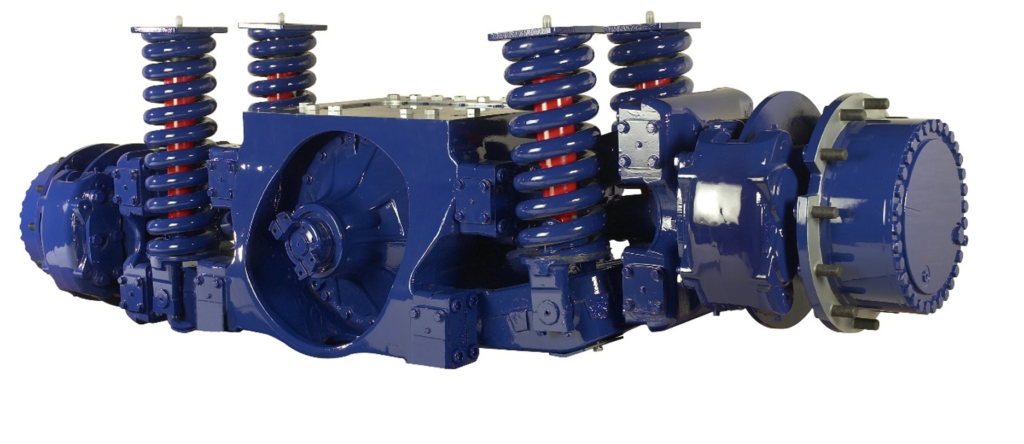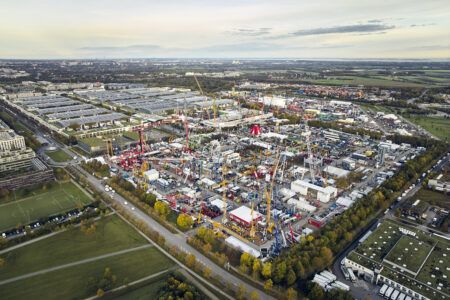Articulated haulers are the unstoppable heroes of the construction equipment world. The ultimate off-road load carriers, their go-anywhere ability means that even the toughest off-road terrain presents no obstacle. And while a certain amount of buffeting for the operator is expected, minimising whole body vibrations is vital in order to prevent long term injury, boost comfort and improve productivity. It was to achieve this that Scottish hauler company Rokbak decided to diverge from the industry norm, and adopt a revolutionary fully independent suspension (IS) on its 28 tonne payload articulated hauler.
Rokbak’s 28 tonne hauler is the first – and remains the only – articulated hauler to adopt a fully independent front suspension system. The approach consists of upper and lower control arms, shock absorbers, coil springs, central differential assembly and wheel ends. The benefits of independent suspension more than compensate for their added complexity and additional cost when compared to the more common ‘A-frame’ live beam axle set-up. Rokbak continues to believe that the benefits of an IS system speak for themselves on its 28-tonne payload machine.
Developed in cooperation with Irish ride and handling experts Timoney Technology, the design of Rokbak’s RA30 suspension is groundbreaking in more ways than one. “The RA30 is truly exceptional, with an ultra-performance system that allows it to go through any kind of trench or bump,” says Timoney’s chief executive José Cuadrado. “It has a top-of-the-range high-performing, heavy duty suspension, with the highest performance available.”
“There is not really an independent system like it on the market,” agrees Paul Smith, principal engineer at Rokbak. “It was unique when it was launched and remains so today, with fundamental benefits over the standard A-frame.
 ABOVE: Independent suspensions, such as this Timoney articulated hauler system, are designed to offer best-in-class vehicle ride and handling
ABOVE: Independent suspensions, such as this Timoney articulated hauler system, are designed to offer best-in-class vehicle ride and handling
The A-frame live beam axle design is cost effective, functional and robust. However, as the left and right wheels are directly connected, whatever happens on one wheel is transmitted to the other. Over rough ground this can result in extensive movement within the cab. With an IS system what happens to each wheel is, as its name suggests, fully independent of the other. Each wheel moves up and down on its own, significantly reducing cab movement. There is less side-to-side movement of the cab and lower lateral acceleration through the structure to the operator. This overall improved ride and handling significantly reduces operator fatigue, resulting in improved concentration, safety and productivity over a shift. With operator fatigue a major issue in the industry, this benefit ought not be underestimated.
“A major factor with our IS system is to keep both wheels flat on the ground at all times. This has multiple benefits, including optimal ground pressure, traction performance, and – during braking when laden especially – safe maneuvering,” says Smith. “At an operator level this results in a hauler that bounces less, is easier to drive, needs fewer corrective steering inputs, and is a less stressful and tiring operating experience. With less scrubbing and bouncing, tyre life is also much improved using an IS system. As tyres are a major factor in total cost of ownership, this is a key economic benefit. And it’s not only operators and tyres that benefit from lower vibrations. As there is more isolation of the sprung mass, reliability and durability of components in the front frame structure is also improved.”
Due to the geometry set-up of independent systems, comfort and capability at speed is improved over rough ground. If you imagine a vintage car with a beam axle in front, an acceptable speed was 30, 40, 50 miles per hour. Once cars were fitted with independent front suspension, that acceptable top speed at least doubled. While the difference isn’t so marked in articulated haulers, the principle remains valid, simply because a hauler fitted with IS is more stable and doesn’t oscillate left and right to the same degree as with a live beam axle.
The robust design and key features of the IS mean high uptime and performance. The whole purpose of IS is to minimise shocks and vibrations to protect the machine structures and operator. This promotes high uptime. Any added complexity or maintenance is compensated by lower repairs and operating costs. More moving parts are serviced by the installation of an auto-grease system.
Peak performance
So, to recap, IS systems tackle vibrations at source, resulting in a hauler that is both operator and productivity friendly. Machines with beam axles typically utilise cab mounts and operator seat suspension to mitigate the impact as best they can.
“Independent suspension systems have been proven on other heavy-duty vehicles that are not so cost sensitive as articulated haulers,” says Timoney’s Cuadrado. “The defence industry is a good example – where performance overrides all other considerations. The RA30 is equipped with the best heavy duty suspension system and provides performance unmatched by anything else on the market.”
“Rokbak’s 28 tonne hauler concept is extremely popular with operators,” agrees Rokbak’s Smith. “With its greater insulation from the terrain they are driving on, operators can easily tell the difference its independent suspension offers – and naturally tend to drive with more confidence and less stress.”





